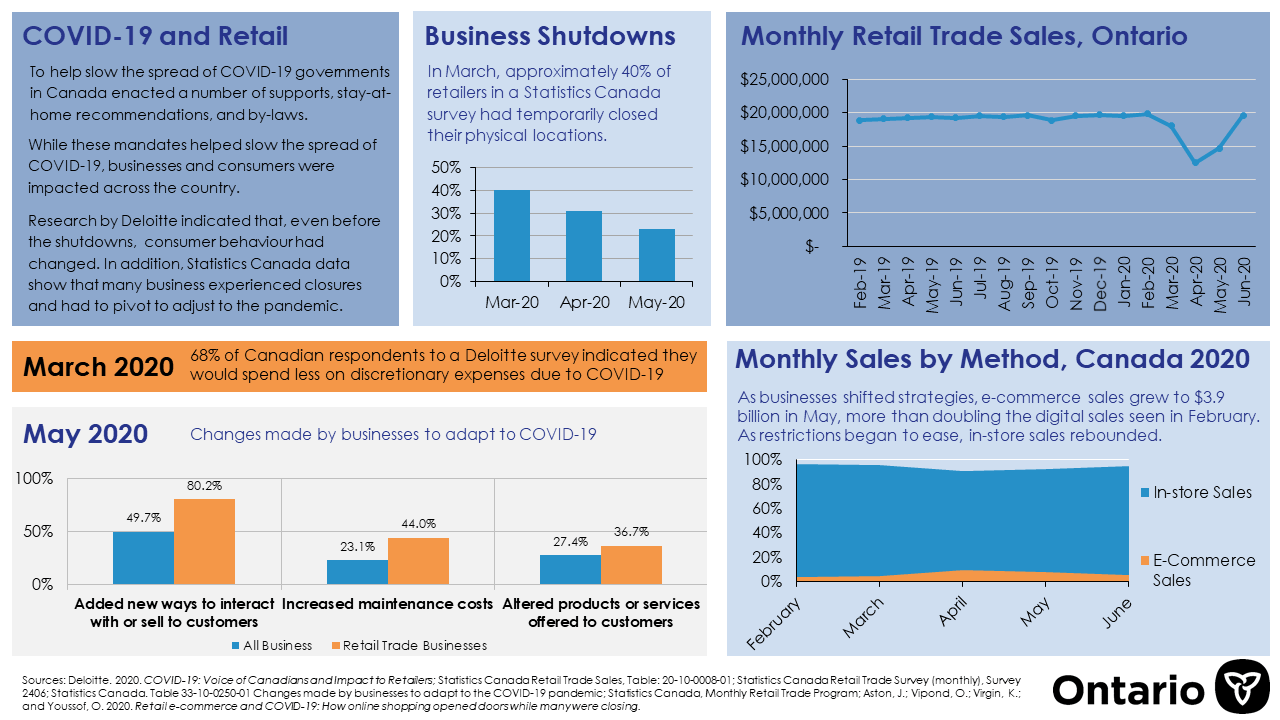This briefing note is one of a series on COVID-19 and its impact on the retail trade sector. This piece focuses on the broader implications of the pandemic with respect to retail trade businesses. Other briefing notes will focus on retail trade employees, the link between retail trade in Niagara and the tourism sector, as well as what a post-pandemic reality might look like for Niagara’s retail trade sector.
To slow the spread of COVID-19, governments in Canada enacted a series of supports, stay-at-home recommendations, and by-laws. Though these mandates helped slow the spread of COVID-19, they also impacted businesses (e.g., closures of non-essential businesses). However, even without government intervention, COVID-19 may have led to a decrease in consumer spending. Between March 16 and 18, 2020 (i.e. before many provincial closure were mandated), Deloitte conducted a survey of 1,001 Canadian residents and found that 68% of respondents already planned to reduce discretionary spending as a result of COVID-19.[1] Further, 61% of respondents expected to spend less time at restaurants and 66% noted they would spend less time at malls.[2]
These stay-at-home mandates and changes in consumer confidence likely had compounding effects on retailers. In March 2020, approximately 40% of retailers responding to a Statistics Canada survey had been forced to temporarily close their physical locations.[3] Locally, 37.1% of retail trade businesses responding to the Niagara Economic Rapid Response Team’s Business Impact Survey noted that, due to COVID-19, by mid-May they were either vulnerable to closure or at risk of imminent closure.[4]
Alongside these changes, retail trade sales within Ontario fell by 38.5%, from $19.9 billion in February to $12.2 billion in April. However, provincial retail trade sales have already rebounded from April’s low to $19.6 billion in June 2020 (see Figure 1). NWPB will monitor this trend as we navigate the continued impacts of COVID-19 and the risk of subsequent outbreaks.
Figure 1 Retail Trade Sales in Ontario, by month

Source: Statistics Canada Retail Trades Sales, Table: 20-10-0008-01 (formerly CANSIM 080-0020). Custom Tabulation.
Retail adjustments in response to the pandemic
To combat the effects of the pandemic during March and April, most retailers worked to adapt their products, sales methods, and strategies for consumer engagement. Data from Statistics Canada show that only 2.8% of Canadian retail trade businesses made no changes to their businesses due to the pandemic. Comparatively, 80.2% of retailers added new ways to interact with or sell to customers, significantly higher than the 49.7% of businesses across all industries that did the same. The five most common methods of adaptation are presented in Table 1.
Table 1. Methods business used to adapt to challenges of COVID-19, Canada
| Percentage of Respondents | ||
| All Industries | Retail Trade | |
| Added new ways to interact with or sell to customers | 49.7% | 80.2% |
| Increased maintenance costs | 23.1% | 44.0% |
| Altered products or services offered to customers | 27.4% | 36.7% |
| Closed temporarily as mandated by government | 25.8% | 28.0% |
| Increased use of virtual connections externally | 25.2% | 25.5% |
Source: Statistics Canada. Table 33-10-0250-01 Changes made by businesses to adapt to the COVID-19 pandemic
As businesses shifted strategies, national e-commerce sales grew to $3.9 billion in May, more than doubling the digital sales seen in February 2020 ($1.6 billion).[5] However, as restrictions began to ease, in-store sales rebounded; therein, e-commerce sales fell to $3.2 billion in June, though this figure is still substantially higher than the $1.6 billion sales figure from February (see Table 2).
Table 2. Monthly percentage of sales by method, retail trade, Canada
| February | March | April | May | June | ||
| Total Sales (in billions) | In-Store | $43.0 | $43.6 | $34.9 | $47.3 | $57.0 |
| E-Commerce | $1.6 | $2.2 | $3.6 | $3.9 | $3.2 | |
| Percentage of Total Sales | In-Store | 96.4% | 95.2% | 90.6% | 92.4% | 94.6% |
| E-Commerce | 3.6% | 4.8% | 9.4% | 7.6% | 5.4% |
Source: Statistics Canada, Monthly Retail Trade Program
Though businesses were forced to make abrupt changes to their methods of sales and consumer engagement due to COVID-19, it is unclear whether those changes will remain after the pandemic. A Brookings Institute report suggested that when the pandemic ends, many traditional retail trade experiences may no longer exist given the adjustments that have been made in response to the pandemic.[6] Over the coming months this project will monitor local and national indicators for retail trade to help us better understand whether COVID-19 is as a catalyst for long-term change within retail trade, or is better understood to be a large, short-term, shock.
Read more from Niagara Workforce Planning Board.
[1] Deloitte. 2020. COVID-19: Voice of Canadians and Impact to Retailers.
[2] Ibid.
[3] Statistics Canada Retail Trade Survey (monthly), Survey 2406. https://www150.statcan.gc.ca/n1/en/daily-quotidien/200721/dq200721a-eng.pdf?st=b2h6SYqY
[4] Niagara COVID-19 Business Impact Survey Part 2. https://niagaracanada.com/wp-content/uploads/sites/7/2020/06/COVID-2-Report_Final-Draft.pdf
[5] Aston, J.; Vipond, O.; Virgin, K.; and Youssof, O. 2020. Retail e-commerce and COVID-19: How online shopping opened doors while many were closing.
[6] Loh, Tracy H. 2020. Brookings Institute: COVID-19 will upend retail, but there are steps we can take to save it.



